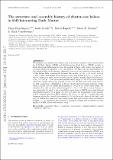Notice
This is not the latest version of this item. The latest version can be found at:https://dspace.mit.edu/handle/1721.1/134863.2
The structure and assembly history of cluster-sized haloes in self-interacting dark matter
| dc.contributor.author | Brinckmann, Thejs | |
| dc.contributor.author | Zavala, Jesús | |
| dc.contributor.author | Rapetti, David | |
| dc.contributor.author | Hansen, Steen H | |
| dc.contributor.author | Vogelsberger, Mark | |
| dc.date.accessioned | 2021-10-27T20:09:32Z | |
| dc.date.available | 2021-10-27T20:09:32Z | |
| dc.date.issued | 2018 | |
| dc.identifier.uri | https://hdl.handle.net/1721.1/134863 | |
| dc.description.abstract | © 2015 The Authors. We perform dark-matter-only simulations of 28 relaxed massive cluster-sized haloes for cold dark matter (CDM) and self-interacting dark matter (SIDM) models, to study structural differences between the models at large radii, where the impact of baryonic physics is expected to be very limited. We find that the distributions for the radial profiles of the density, ellipsoidal axial ratios and velocity anisotropies (β) of the haloes differ considerably between the models (at the ~1σ level), even at ≳10 per cent of the virial radius, if the self-scattering cross-section is σ/mχ = 1 cm2 g-1. Direct comparison with observationally inferred density profiles disfavours SIDM for s/mχ = 1 cm2 g-1, but in an intermediate radial range (~3 per cent of the virial radius), where the impact of baryonic physics is uncertain. At this level of the crosssection, we find a narrower β distribution in SIDM, clearly skewed towards isotropic orbits, with no SIDM (90 per cent of CDM) haloes having β > 0.12 at 7 per cent of the virial radius. We estimate that with an observational sample of ~30 (~1015 M⊙) relaxed clusters, β can potentially be used to put competitive constraints on SIDM, once observational uncertainties improve by a factor of a few.We study the suppression of the memory of halo assembly history in SIDM clusters. For σ/mχ = 1 cm2 g-1, we find that this happens only in the central halo regions (~1/4 of the scale radius of the halo), and only for haloes that assembled their mass within this region earlier than a formation redshift zf ~ 2. Otherwise, the memory of assembly remains and is reflected in ways similar to CDM, albeit with weaker trends. | |
| dc.language.iso | en | |
| dc.publisher | Oxford University Press (OUP) | |
| dc.relation.isversionof | 10.1093/MNRAS/STX2782 | |
| dc.rights | Creative Commons Attribution-Noncommercial-Share Alike | |
| dc.rights.uri | http://creativecommons.org/licenses/by-nc-sa/4.0/ | |
| dc.source | arXiv | |
| dc.title | The structure and assembly history of cluster-sized haloes in self-interacting dark matter | |
| dc.type | Article | |
| dc.relation.journal | Monthly Notices of the Royal Astronomical Society | |
| dc.eprint.version | Author's final manuscript | |
| dc.type.uri | http://purl.org/eprint/type/JournalArticle | |
| eprint.status | http://purl.org/eprint/status/PeerReviewed | |
| dc.date.updated | 2019-06-12T12:22:58Z | |
| dspace.orderedauthors | Brinckmann, T; Zavala, J; Rapetti, D; Hansen, SH; Vogelsberger, M | |
| dspace.date.submission | 2019-06-12T12:23:00Z | |
| mit.journal.volume | 474 | |
| mit.journal.issue | 1 | |
| mit.metadata.status | Authority Work and Publication Information Needed |
